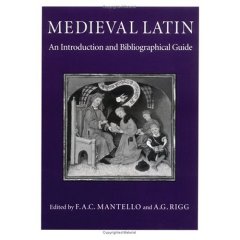Medieval Latin. An Introduction and Bibliographical Guide [Reference & Dictionary]

F. A. C. Mantello & A. G. Rigg(ed.)
Medieval Latin. An Introduction and Bibliographical Guide.
New York: CUA Press, 1996, 774 p.
Acknowledgements
Part 1
A: Introduction
AA: Medieval Latin, past and present
AB: Background, aims, and structure of the present guide
AC: Organization
AD: Abbreviations
B: General reference and research tools
BA: Bibliographical guides and surveys
BB: Latin dictionaries and related works
BC: Repertories of authors, texts, and initia
BD: Encyclopedias, encyclopedic dictionaries, and related works
BE: Computer resources
BF: Other basic reference and research aids
BG: Principal series and collections of Latin texts
BH: Periodicals
Part 2
C: Medieval Latin philology
CA: Introduction, by A. G. Rigg
CB: Orthography and pronunciation, by A. G. Rigg
CC: Morphology and syntax, by A. G. Rigg
CD: Vocabulary, word formation, and lexicography, by Richard Sharpe
CE: Metrics, by A. G. Rigg
CF: Prose styles and cursus, by Terence O. Tunberg
CG: Latin and the vernacular languages, by Michael W. Herren
CH: Humanistic Latin, by Terence O. Tunberg
D-E-F: Varieties of Medieval latinity
DA: Christian and biblical Latin, by Daniel Sheerin
DB: The liturgy, by Daniel Sheerin
DC: Ecclesiastical and university administration, by Norman Zacour
DD: Secular administration, by Brigitte Bedos-Rezak
DE: Chartes, deeds, and diplomatics, by Richard Sharpe
DF: Canon law, John Gilchrist
DG: Roman and secular law, by Kenneth Pennington
DH: Theology and philology, by Stephen F. Brown
DI: Grammar, Vivien A. Law
DJ: Music, by Nancy Phillips
DK: Commerce, John H. Pryor
DL: Latin in everyday life, by Richard Sharpe
EA: Science: Introduction, by Faith Wallis
EB: Mathematics and geometry, by Barnabas Hughes, O. F. M.
EC: Physics, by Edith Dudley Sylla
ED: Astronomy, cosmology, and cosmograohy, by Edward Grant
EE: Astrology, by Charles Burnett
EF: Chronology and systems of dating, by Faith Wallis
EG: Cartography and its written sources, P. D. A. Harvey
EH: Zoology and physiology, by James J. Scanlan, M. D.
EI: Botany, by R. James Long
EJ: Geology, by John M. Riddle
EK: Chemistry and alchemy, by Michela Pereira
EL: Medicine, by Peter Murray Jones
EM: Magic, by Richard Kieckhefer
FA: Technology and crafts: Introduction, by Bert Hall
FB: Artes mechanicae, by Elspeth Whitney
FC: Architecture, Joseph F. O'Connor
FD: Weights and measures, by Ronald Edward Zupko
FE: Weapons and warfare, E. Malcom Parkinson
FF: Ships and seafaring, by John H. Pryor
FG: Agriculture, animal husbandry, and forestry, by John Langdon
FH: Manuscripts production, by R. H. Rouse
FI: Panel and wall painting, mosaics, metalwork, and other decorative arts, by Caecilia Davis-Weyer
FJ: Textiles, by John H. Munro
FK: Mining and ore processing, by Pamela O. Long
FL: Minting and money, by Alan M. Stahl
FM: Mills and milling, by John Muendel
Part 3
G-H: Varieties of Medieval Latin literature
GA: Towards a history of Medieval Latin literature, by Jan M. Ziolkowski
GB: The Latin literature of late antiquity, by Michael Roberts
GC: Epic, by Jan M. Ziolkowski
GD: Beast epic and fable, by Jill Mann
GE: Satire, by A. G. Rigg
GF: Proverbs and epigrams, by A. G. Rigg
GG: Drama, by Stephen K. Wright
GH: Exempla, by Nigel F. Palmer
GI: Lyric, by Christopher J. McDonough
GJ: Hymns, by Daniel Sheerin
GK: Biograohy, by Walter Berschin
GL: Hagiography, by David Townsend
GM: Rhetoric, by James J. Murphy
GN: Historiography, by Roger Ray
GO: Epistolography, by Julian Haseldine
GP: Sermons, by Beverly Mayne Kienzle & David L. d'Avray
GQ: Pastoralia: the popular literature of the care of souls, by Joseph Goering
GR: Debates and dialogues, by Peter Binkley
GS: Travel literature, by Jean Richard
GT: Vision literature, by Peter Dinzelbacher
GU: Devotional and mystical literature, by Thomas H. Bestul
GV: Encyclopedias, by Gregory G. Guzman
GW: Anthologies and florilegia, by A. G. Rigg
HA: Medieval translations: Latin and Hebrew, by Charles H. Manekin
HB: Medieval translations: Latin and Greek, by Bernice M. Kaczynski
HC: Medieval translations: Latin and Arabic, by Deborah L. Black
HD: Medieval translations: Latin and the vernacular languages, Jeanette M. A. Beer
Indices
I. Ancient, late antique, medieval, and renaissance authors and works
II. Modern authors, editors, and general works of reference
* * * * * * * * * *
コメントされた文献紹介が中心で便利。こういうものが学生の小遣い程度で入手できるアメリカは素直にすごいと思う。学生であれば英語は誰でも読めるので、マーケットが全世界ということになる。通読するようなものではないが、ともかく中世ラテンの世界の広さに驚く。中世西洋の共通言語だから当たり前なのだが。自分が相手にしているラテン語など、全体から見れば吹けば飛ぶような質量しかない。執筆者も一部の著名人を除いて知らない。多くは文献学者、文学者、言語学者なのだろう。
中世ラテンは古典ラテンの知識があってはじめて生きてくる。単語も8割がたは古典ラテン語の辞書でまかなう事ができる。もちろん偏差の大きい中世ラテンには専用の辞書が必要で、法制史料であればニールマイヤー、教会史料であればブレーズと相場が決まっていたのだが、最近フランスで歴史家の関与する中世ラテン語辞書が出た。
Michel Parisse et al.(ed.), Lexique Latin-Français : Antiquité et Moyen Age. Paris: Picard, 2006, 725 p.
ただし、私は見ていないのでなんともいえない。
日本語で中世ラテンへの学習というのはなかなか難しいが、私の知る限り一冊だけある。
国原吉之助『中世ラテン語入門』(南江堂 改訂版1981 初版1975), xviii+253頁
手引きとして、
千葉敏之「gigantibus, quorum umeris insideo nanus―中世ラテン語と歴史家のための諸道具―」『クリオ』15(2001), 97-118頁
中世末期から近世の人文主義者のラテン語は、私も僅かしか読んだ事がないが、古典ラテンを読む感覚に近いように思う。つまり、通常中世ラテンと呼ばれるやや粗雑で単純化されたものに比べて、レトリックが複雑である。古典の道具でまかなえるのだろうか。

